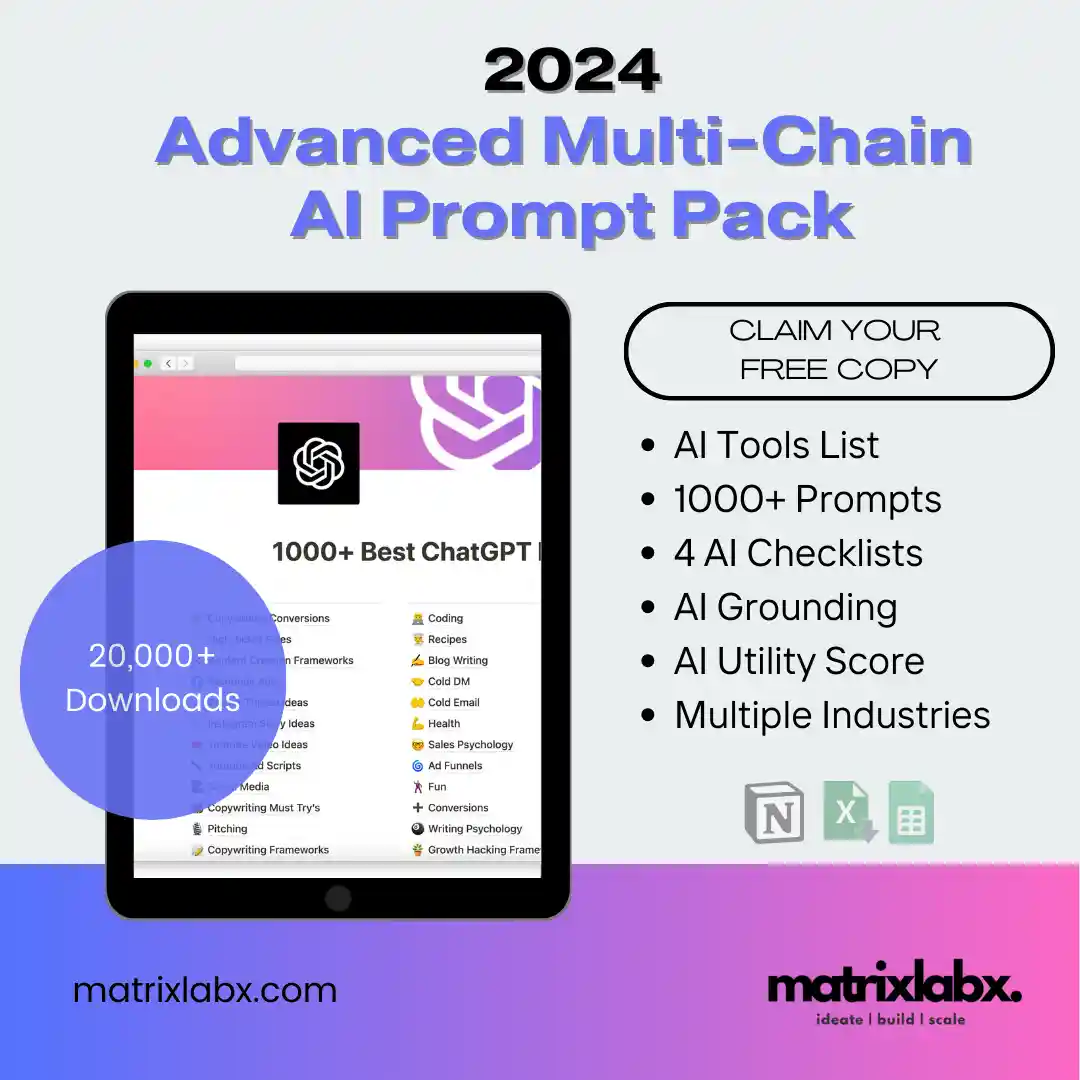AI Marketing Budget Blueprint: A Step-by-Step Guide to Smart Investments
AI Marketing Budget Blueprint: A Step-by-Step Guide to Smart Investments
What is the AI Marketing Budget Blueprint
The AI Marketing Budget Blueprint is a comprehensive framework that helps businesses allocate their marketing budgets effectively in the age of artificial intelligence (AI).
It outlines the various AI applications that can be used to optimize marketing campaigns, improve ROI, and achieve business goals. The blueprint also guides how to evaluate the effectiveness of AI-powered marketing initiatives.
Key components of the AI Marketing Budget Blueprint:
- AI Applications for Marketing: The blueprint identifies the top AI applications to enhance marketing efforts. These include:
- Predictive analytics: Leveraging AI to anticipate customer behavior, predict campaign performance, and identify potential market trends.
- Dynamic creative optimization: Using AI to personalize ad creatives based on real-time data and user behavior.
- Personalized ad targeting: Employing AI to target ads to the most relevant audience segments, maximizing ad effectiveness.
- Instant campaign analytics: Gaining real-time insights into campaign performance using AI-powered analytics tools.
- AI Budget Allocation: The blueprint provides a framework for allocating marketing budget to AI initiatives. It suggests considering factors such as:
- Business goals: Aligning AI investments with specific marketing objectives, such as increasing lead generation or improving customer retention.
- AI maturity level: Assessing the company’s current AI capabilities and allocating resources accordingly.
- Return on investment (ROI): Prioritizing AI projects demonstrating a clear path to measurable ROI.
- Data availability: Ensuring sufficient data is available to train and optimize AI models.
- Evaluating AI Marketing Effectiveness: The blueprint emphasizes the importance of evaluating the effectiveness of AI-powered marketing initiatives. It suggests using metrics such as:
- Campaign performance: Measuring the impact of AI on key marketing metrics, such as click-through rates, conversion rates, and customer acquisition costs.
- Customer engagement: Tracking customer engagement metrics, such as time spent on site, open rates for email campaigns, and social media engagement.
- ROI: Calculating the ROI of AI-powered marketing initiatives, comparing the costs of AI solutions to the incremental revenue or savings achieved.
- Continuous Improvement: The blueprint advocates for a continuous improvement approach to AI marketing. It suggests:
- A/B testing: Experimenting with different AI-powered marketing strategies to determine the most effective approaches.
- Data-driven decision-making: Using data insights to refine AI models and optimize marketing campaigns over time.
- Staying updated with AI advancements: Continuously evaluating new AI applications and incorporating them into marketing strategies as they become relevant.
By following the AI Marketing Budget Blueprint, businesses can make informed decisions about allocating their marketing budgets to AI initiatives, maximizing the impact of AI on their marketing efforts, and achieving their business goals.

Sarah, the newly appointed CMO of an up-and-coming tech company, stared at the whiteboard in her office. It was adorned with sticky notes, charts, and doodles, all pointing to one looming challenge: integrating artificial intelligence into her marketing campaigns. The company’s Board of Directors had made it clear: AI was the future. But where to begin?
In her previous roles, Sarah managed sizeable marketing budgets and led several successful campaigns. However, AI was a realm she had yet to dive into fully. The vast landscape of AI possibilities, from chatbots to predictive analytics, felt overwhelming.
She began by calling a meeting with her core marketing team. “We need a comprehensive strategy to integrate AI into our marketing initiatives,” Sarah declared as the meeting started. The room buzzed with excitement and anxiety. Like Sarah, many on the team were familiar with AI’s potential but were still determining its practical application in their domain.
Jake, the digital marketing lead, was the first to chime in. “What if we started by identifying our biggest pain points and seeing where AI might fit in?”
The team began listing challenges: the unpredictability of ad spend ROI, understanding customer behavior on their e-commerce platform, and tailoring content for different audience segments.
Elaine, the customer insights manager, then mentioned a seminar she’d recently attended. “There’s a lot of buzz around predictive analytics. It can help forecast customer behavior based on historical data. Maybe that’s a start?”
Inspired, Sarah decided to reach out to experts in the field. She organized a workshop inviting AI consultants and product vendors. During the workshop, they delved into AI’s potential in marketing, exploring tools that could optimize ad spend, enhance customer experience, and provide actionable insights from big data.
The workshop was a turning point. Sarah realized that instead of allocating a lump sum towards AI, it was crucial to align AI investments with specific marketing challenges. She began by earmarking a portion of the budget for a pilot program on predictive analytics, focusing on improving ad spend efficiency.
Months into the pilot, the results were promising. The AI-driven predictive model enabled the team to identify the most effective channels and times for their ads, optimizing their budget and increasing ROI.
Encouraged by the pilot’s success, Sarah expanded the AI budget. Chatbots were introduced to the company’s website, offering real-time assistance and significantly boosting user engagement. Machine learning algorithms began analyzing user behavior on the e-commerce platform, allowing for personalized product recommendations.
Sarah’s initial apprehension about AI had transformed into a strategic embrace. She regularly attended AI conferences, keeping herself updated on the latest trends and ensuring her team was always a step ahead.
By the end of the year, not only had the company’s marketing efforts become more efficient and personalized, but Sarah had also established herself as a pioneer in AI-driven marketing strategies. She had taken a journey from uncertainty to mastery, proving that with the right approach, even the most daunting challenges could become opportunities.
As the CMO of a $50 million travel hospitality company, your marketing budget will vary depending on several factors, including your company’s goals, target market, and competitive landscape.
However, as a general rule of thumb, you can allocate between 9% and 15% of your revenue to marketing. For a $50 million company, this would translate to a budget of between $4.5 million and $7.5 million.

Better Search Ranking
Better Search Ranking in 90 days
SEO is extremely important for companies to rank well in search engines because it is the primary way that people find information online.
Here is a breakdown of how you might allocate your marketing budget:
- Digital marketing (40-50%): This includes search engine marketing (SEM), social media marketing (SMM), display advertising, and email marketing.
- Content marketing (20-30%): This includes creating blog posts, infographics, videos, and other types of content that your target audience will find valuable.
- Public relations (10-20%): This includes building relationships with journalists and influencers to get positive press coverage for your company.
- Events and sponsorships (5-10%): This includes sponsoring industry events and conferences, as well as attending trade shows and expos.
Of course, the exact allocation of your marketing budget will depend on your specific needs and priorities. However, this breakdown can give you a starting point for planning your budget.
Here are some additional factors to consider when budgeting for marketing:
- Your company’s growth stage: If you are a startup, you will likely need to allocate a larger percentage of your revenue to marketing to grow your customer base. If you are a more established company, you can allocate a smaller percentage of your revenue to marketing, as you will have a more established brand and customer base.
- Your target market: If your target market is highly engaged online, you must allocate a larger portion of your marketing budget to digital marketing. If your target market is less engaged online, you may need to allocate a larger portion of your marketing budget to traditional marketing channels, such as television and print advertising.
- Your competitive landscape: If you are operating in a highly competitive industry, you must allocate a larger portion of your marketing budget to marketing to stand out.
As artificial intelligence (AI) continues to revolutionize industries across the globe, its impact on the marketing landscape is becoming increasingly profound. Marketers now face many AI-powered tools and solutions that can streamline operations, enhance customer experiences, and drive business growth.
However, with this wealth of options comes the challenge of making informed investment decisions. This AI Marketing Budget Blueprint is designed to provide CMOs and marketing leaders with a comprehensive framework for allocating resources effectively and maximizing the return on their AI investments.

Step 1: Define Business Goals and Objectives
- Problems: Marketing objectives sometimes must be more specific or tied to business goals.
- Solution: Clearly define and prioritize business goals, such as acquiring new customers, increasing retention, or expanding market share.
Step 2: Define Your AI Marketing Objectives
Clearly defined objectives are essential for guiding your AI investment decisions. Identify areas where AI can add value, such as improving lead generation, enhancing customer engagement, or optimizing ad spend.
Align your AI objectives with overall business goals to ensure that AI investments drive strategic growth.
Step 3: Research AI Marketing Solutions
Conduct extensive research to identify AI marketing solutions that align with your objectives and budget.
Explore both vendor-provided solutions and open-source options. Evaluate the features, performance, and scalability of each solution to ensure it meets your specific requirements.
Step 4: Conduct Pilot Projects
Before committing to full-scale implementation, pilot projects provide an opportunity to test the effectiveness of AI solutions in a controlled environment.
Select specific use cases for your pilot projects and track key metrics to assess the impact of AI on marketing performance.
Step 5: Allocate Resources and Budget
Based on your research and pilot projects, determine how to allocate resources and budget for AI implementation.
Consider factors such as the cost of AI solutions, training requirements, and ongoing maintenance expenses. Prioritize investments based on the potential ROI and strategic alignment with business goals.
Step 6: Establish Measurement and Evaluation Framework
Define clear metrics to measure the success of your AI marketing initiatives. Track key performance indicators (KPIs) such as lead generation rates, customer engagement metrics, and return on ad spend (ROAS).
Regularly evaluate the performance of your AI solutions and make adjustments as needed.
Step 7: Foster a Culture of Continuous Improvement
Create a culture of continuous improvement around AI adoption. Encourage collaboration between marketing, data science, and IT teams to ensure that AI solutions are integrated effectively into your marketing processes.
Regularly review and update your AI strategy to adapt to evolving market trends and technological advancements.
AI Marketing Budget Blueprint

Step 1: Define Business Goals and Objectives
- Problems: Marketing objectives sometimes must be more specific or tied to business goals.
- Solution: Clearly define and prioritize business goals, such as acquiring new customers, increasing retention, or expanding market share.
Step 2: Data Collection and Integration
- Problems: Fragmented data sources, outdated or irrelevant data, and need for more standardization.
- Solution:
- Integrate all marketing data sources into a centralized platform.
- Regularly update and clean data.
- Ensure data standardization across platforms.
Step 3: AI Model Selection and Training
- Problems: Choosing the wrong AI model, inadequate training data, and overlooking biases.
- Solution:
- Choose AI models based on specific marketing objectives.
- Use a diverse dataset for training to avoid biases.
- Continuously train the model with new data.
Step 4: Forecasting and Predictive Analysis
- Problems: Reliance on outdated forecasting methods and ignoring real-time insights.
- Solution:
- Use AI for predictive analysis to forecast future marketing trends and customer behaviors.
- Continuously update forecasts based on real-time data.
Are Your Marketing Efforts a Shot in the Dark? Let’s Turn on the Spotlight!
Imagine having the clarity of seeing your marketing strategy from a bird’ s-eye view and understanding every nuance of your campaigns. Our comprehensive audit delves into the core of your marketing DNA, dissecting each campaign with surgical precision to identify the powerhouse strategies and weed out the underperformers.

Step 5: Budget Allocation
- Problems: Allocating budget inefficiently, aligning with objectives, and needing to be adaptive.
- Solution:
- Use AI to analyze the ROI of different marketing channels and allocate budget accordingly.
- Set aside a portion of the budget for experimentation and emerging marketing channels.
Step 6: Monitoring and Optimization
- Problems: Not monitoring in real-time, slow reaction to changes, and not leveraging AI insights.
- Solution:
- Deploy AI-driven dashboards to monitor campaigns in real time.
- Adjust strategies based on AI recommendations for optimization.
Step 7: Feedback Loop and Continuous Learning
- Problems: Not updating models based on new outcomes and not learning from past mistakes.
- Solution:
- Implement a feedback loop where the AI system learns from every campaign.
- Use post-campaign analysis to refine future strategies and improve the AI model.
Step 8: Stakeholder Communication
- Problems: Lack of transparency and understanding of AI decisions among stakeholders.
- Solution:
- Create transparent reports on how AI decisions are made.
- Regularly update stakeholders on AI-driven strategies and results.
Step 9: Compliance and Ethical Considerations
- Problems: Overlooking data privacy laws and potential ethical dilemmas with AI usage.
- Solution:
- Stay updated on data privacy regulations and ensure compliance.
- Establish ethical guidelines for AI usage in marketing.
Step 10: Regular Review and Updates
- Problems: Not updating the blueprint and AI models regularly.
- Solution:
- Schedule periodic reviews of the blueprint to ensure it remains relevant.
- Update AI models based on the latest technological advancements and industry best practices.
By following this comprehensive blueprint, organizations can ensure an effective and efficient AI-driven marketing budget that is adaptive, transparent and delivers maximum ROI.
Conclusion
AI is transforming the marketing landscape, offering marketers many opportunities to enhance their strategies and drive business growth.
By implementing a strategic AI marketing budget blueprint, CMOs and marketing leaders can make informed investment decisions, maximize the ROI of their AI initiatives, and position their organizations for success in the AI-driven marketing era.
Before embarking on AI implementation, it is crucial to conduct a thorough assessment of your current marketing landscape. This involves identifying your marketing goals, target audience, and current marketing channels.
Additionally, evaluate your existing data infrastructure and analytics capabilities to determine your organization’s readiness for AI adoption.

